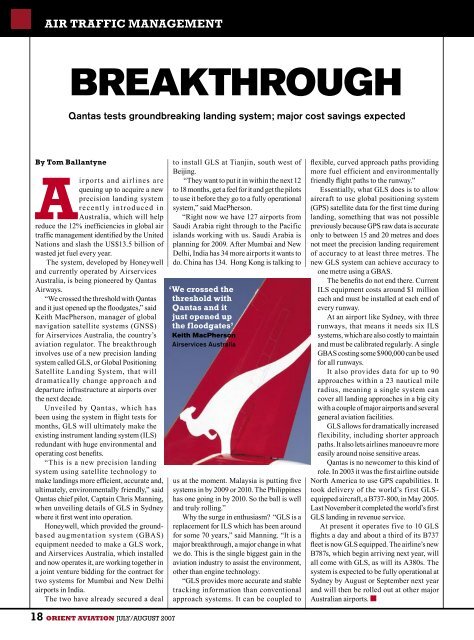Malaysia Airlines - Orient Aviation
Malaysia Airlines - Orient Aviation
Malaysia Airlines - Orient Aviation
Create successful ePaper yourself
Turn your PDF publications into a flip-book with our unique Google optimized e-Paper software.
AIR TRAFFIC MANAGEMENT<br />
BREAKTHROUGH<br />
Qantas tests groundbreaking landing system; major cost savings expected<br />
By Tom Ballantyne<br />
Air por ts and airlines are<br />
queuing up to acquire a new<br />
precision landing system<br />
recently i nt roduced i n<br />
Australia, which will help<br />
reduce the 12% inefficiencies in global air<br />
traffic management identified by the United<br />
Nations and slash the US$13.5 billion of<br />
wasted jet fuel every year.<br />
The system, developed by Honeywell<br />
and currently operated by Airservices<br />
Australia, is being pioneered by Qantas<br />
Airways.<br />
“We crossed the threshold with Qantas<br />
and it just opened up the floodgates,” said<br />
Keith MacPherson, manager of global<br />
navigation satellite systems (GNSS)<br />
for Airservices Australia, the country’s<br />
aviation regulator. The breakthrough<br />
involves use of a new precision landing<br />
system called GLS, or Global Positioning<br />
Satellite Landing System, that will<br />
dramatically change approach and<br />
departure infrastructure at airports over<br />
the next decade.<br />
Unveiled by Qantas, which has<br />
been using the system in flight tests for<br />
months, GLS will ultimately make the<br />
existing instrument landing system (ILS)<br />
redundant with huge environmental and<br />
operating cost benefits.<br />
“This is a new precision landing<br />
system using satellite technology to<br />
make landings more efficient, accurate and,<br />
ultimately, environmentally friendly,” said<br />
Qantas chief pilot, Captain Chris Manning,<br />
when unveiling details of GLS in Sydney<br />
where it first went into operation.<br />
Honeywell, which provided the groundbased<br />
augmentation system (GBAS)<br />
equipment needed to make a GLS work,<br />
and Airservices Australia, which installed<br />
and now operates it, are working together in<br />
a joint venture bidding for the contract for<br />
two systems for Mumbai and New Delhi<br />
airports in India.<br />
The two have already secured a deal<br />
to install GLS at Tianjin, south west of<br />
Beijing.<br />
“They want to put it in within the next 12<br />
to 18 months, get a feel for it and get the pilots<br />
to use it before they go to a fully operational<br />
system,” said MacPherson.<br />
“Right now we have 127 airports from<br />
Saudi Arabia right through to the Pacific<br />
islands working with us. Saudi Arabia is<br />
planning for 2009. After Mumbai and New<br />
Delhi, India has 34 more airports it wants to<br />
do. China has 134. Hong Kong is talking to<br />
‘We crossed the<br />
threshold with<br />
Qantas and it<br />
just opened up<br />
the floodgates’<br />
Keith MacPherson<br />
Airservices Australia<br />
us at the moment. <strong>Malaysia</strong> is putting five<br />
systems in by 2009 or 2010. The Philippines<br />
has one going in by 2010. So the ball is well<br />
and truly rolling.”<br />
Why the surge in enthusiasm? “GLS is a<br />
replacement for ILS which has been around<br />
for some 70 years,” said Manning. “It is a<br />
major breakthrough, a major change in what<br />
we do. This is the single biggest gain in the<br />
aviation industry to assist the environment,<br />
other than engine technology.<br />
“GLS provides more accurate and stable<br />
tracking information than conventional<br />
approach systems. It can be coupled to<br />
flexible, curved approach paths providing<br />
more fuel efficient and environmentally<br />
friendly flight paths to the runway.”<br />
Essentially, what GLS does is to allow<br />
aircraft to use global positioning system<br />
(GPS) satellite data for the first time during<br />
landing, something that was not possible<br />
previously because GPS raw data is accurate<br />
only to between 15 and 20 metres and does<br />
not meet the precision landing requirement<br />
of accuracy to at least three metres. The<br />
new GLS system can achieve accuracy to<br />
one metre using a GBAS.<br />
The benefits do not end there. Current<br />
ILS equipment costs around $1 million<br />
each and must be installed at each end of<br />
every runway.<br />
At an airport like Sydney, with three<br />
runways, that means it needs six ILS<br />
systems, which are also costly to maintain<br />
and must be calibrated regularly. A single<br />
GBAS costing some $900,000 can be used<br />
for all runways.<br />
It also provides data for up to 90<br />
approaches within a 23 nautical mile<br />
radius, meaning a single system can<br />
cover all landing approaches in a big city<br />
with a couple of major airports and several<br />
general aviation facilities.<br />
GLS allows for dramatically increased<br />
flexibility, including shorter approach<br />
paths. It also lets airlines manoeuvre more<br />
easily around noise sensitive areas.<br />
Qantas is no newcomer to this kind of<br />
role. In 2003 it was the first airline outside<br />
North America to use GPS capabilities. It<br />
took delivery of the world’s first GLSequipped<br />
aircraft, a B737-800, in May 2005.<br />
Last November it completed the world’s first<br />
GLS landing in revenue service.<br />
At present it operates five to 10 GLS<br />
flights a day and about a third of its B737<br />
fleet is now GLS equipped. The airline’s new<br />
B787s, which begin arriving next year, will<br />
all come with GLS, as will its A380s. The<br />
system is expected to be fully operational at<br />
Sydney by August or September next year<br />
and will then be rolled out at other major<br />
Australian airports.<br />
18 ORIENT AVIATION JULY/AUGUST 2007








![OAMag-V7N4-Cover [Converted] - Orient Aviation](https://img.yumpu.com/48598575/1/190x255/oamag-v7n4-cover-converted-orient-aviation.jpg?quality=85)








